A guide for advanced learners: How to use Say and Tell correctly
Ah, “say” and “tell.” Those tricky twins of the English language. Even advanced learners can sometimes get them mixed up. But don’t worry! This guide will help you understand how to use Say and Tell fluently and correctly.
How to use the verb say and tell correctly.
What’s in this guide?
Hi EDA followers,
I notice that my students often get the structure wrong when using the verb ‘say’ and the verb ‘tell’, especially when they are storytelling or giving a presentation. Common mistakes include phrases like “The article tells about….” or “As I told before….”.
I’d like to create a post dedicated to this topic and hopefully clarify the correct usage of these verbs to enhance your fluency and precision.
I hope you enjoy it!

with love, Kerin
- What's in this guide?
- The Essence of "Say"
- The Power of "Tell"
- Telling Tales: Collocations with "Tell"
- Using "Tell" for instructions or commands
- "Say" vs. "Tell" in Reported Speech:
- How to correct common mistakes with "Say" and "Tell"
- Other useful verbs to replace "say" and "tell"
- Additional Examples to use when giving a presentation or talk
The Essence of “Say”
Think of “say” as the all-purpose verb for using your voice to express yourself. It doesn’t need a specific person to hear you, just the act of speaking.
- “She said she loved the new restaurant.” (No mention of who she said it to)
- “The fortune cookie said, ‘A wise person learns from their mistakes.'” (The cookie isn’t exactly talking)
- “He said ‘Ouch!’ when he stubbed his toe.” (Direct speech is A-okay with “say”)
The Power of “Tell”
“Tell” is all about giving information to someone in particular. It involves a clear speaker and listener.
Let me say that again! (No pun intended) “Tell” is all about giving information to someone
- “The teacher told us the history of the pyramids.” (Tells who received the information)
- “Can you tell me what time it is?” (Specific request for information)
Telling Tales: Collocations with “Tell”
Now look at this example that breaks the pattern we have just learned: “She told a story about her adventures in Thailand.”
“Tell” loves to team up with other words to create specific expressions: we call this collocations. In these cases, we DON’T use the pattern: tell + someone + something
Here are some common collocations that I recommend learning:
- Tell a story: Share a narrative with a beginning, middle, and end.
- Tell a joke: Make someone laugh with a humorous anecdote.
- Tell the truth: Be honest and upfront about something.
- Tell a lie: Give false information intentionally.
- Tell the time: Indicate the current hour and minute.
- Tell the difference: Explain how two things are not the same.
- Tell someone off: Scold or reprimand someone.
Using “Tell” for instructions or commands
Sometimes, “tell” gets to borrow a bit from “say.” When reporting instructions or commands, “tell” can be followed by “to + infinitive.”
- “The coach told the players to run ten laps.” (Tells the action someone instructed)
“Say” vs. “Tell” in Reported Speech:
When reporting what someone said, “say” introduces the exact words, while “tell” focuses on the content.
- “He said, ‘I’ll be there in an hour.'” (Direct speech with “say”)
- “She told me she would be there in an an hour.” (Indirect speech with “tell”)
Remember: “Tell” needs someone to listen, while “say” can stand alone.
Bonus Tip: “Say” can also be used with indirect speech, but it’s less common than “tell.”
- “He said that he was on his way.” (Indirect speech with “say”)
How to correct common mistakes with “Say” and “Tell”
Examples:
- “As Laura said me, it is important to….” ❌
- “As Laura said, it is important to….” ✅
- “Marco said a really funny story” ❌
- “Marco told a really funny story” ✅
Incorrect:
- “As Susan told, it is important to….” ❌
- “As I told before, ….” ❌
Correct:
- “As Susan told US, it is important to….” ✅
- “As Susan told YOU, it is important to….” ✅
- “As I told YOU before, ….” ✅
!!! When using “tell,” always remember to include the person you are addressing. This keeps your sentences clear and grammatically correct. !!!
Other useful verbs to replace “say” and “tell”
To avoid repetition and add variety to your language, consider using these verbs, which follow their own patterns:
- Mention:MENTION something (TO SOMEONE)
- “As Enrico mentioned earlier, it is important to….” ✅
- “As Enrico mentioned to us earlier, it is important to….” ✅
- Remark:REMARK something (TO SOMEONE)
- “As Andrew remarked earlier, it is important to….” ✅
- “As Andrew remarked to us earlier, it is important to….” ✅
Additional Examples to use when giving a presentation or talk
Here are some examples to guide you in using these verbs correctly:
- “As Anna told us/you, it is important to….”
- “As Anna said, it is important to….”
- “As Claire mentioned earlier, it is important to….”
- “As Claire remarked earlier, it is important to….”
- “As I said earlier, ….”
- “As I mentioned earlier/yesterday, ….”
- “As we discussed earlier, ….”
- “We talked about this earlier, ….”
By paying attention to these patterns and varying your vocabulary, you can communicate more effectively and with greater clarity in both your storytelling and presentations.
With a little practice and this guide, you’ll be a master of “say” and “tell” in no time!
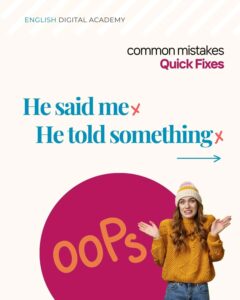
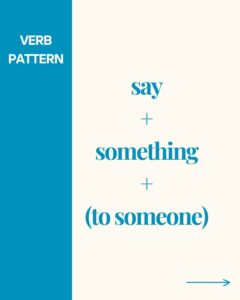

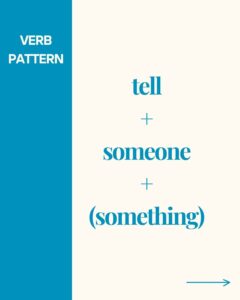

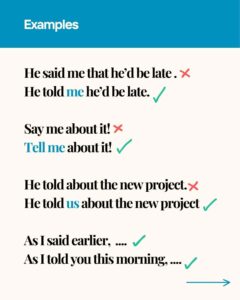

For more common mistakes and quick fixes make sure you follow on LinkedIn
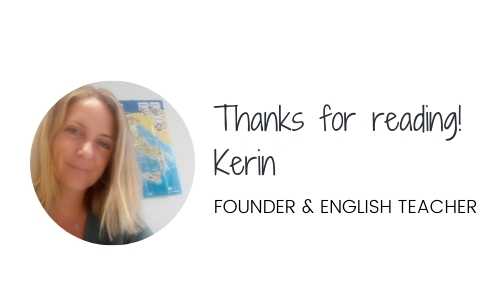
Ps. Want to improve your English and move towards English proficiency? Discover all my courses here
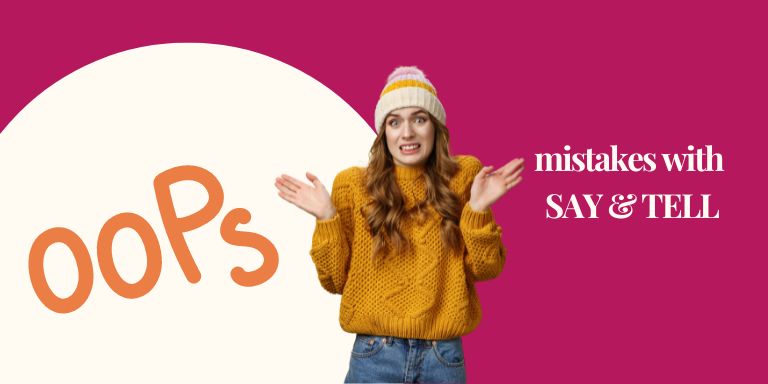
Wonderful explanation!I have never read anything so clear and useful!Thank You
patrizia
So glad you found it useful Patrizia. Thank you for your comment xxx